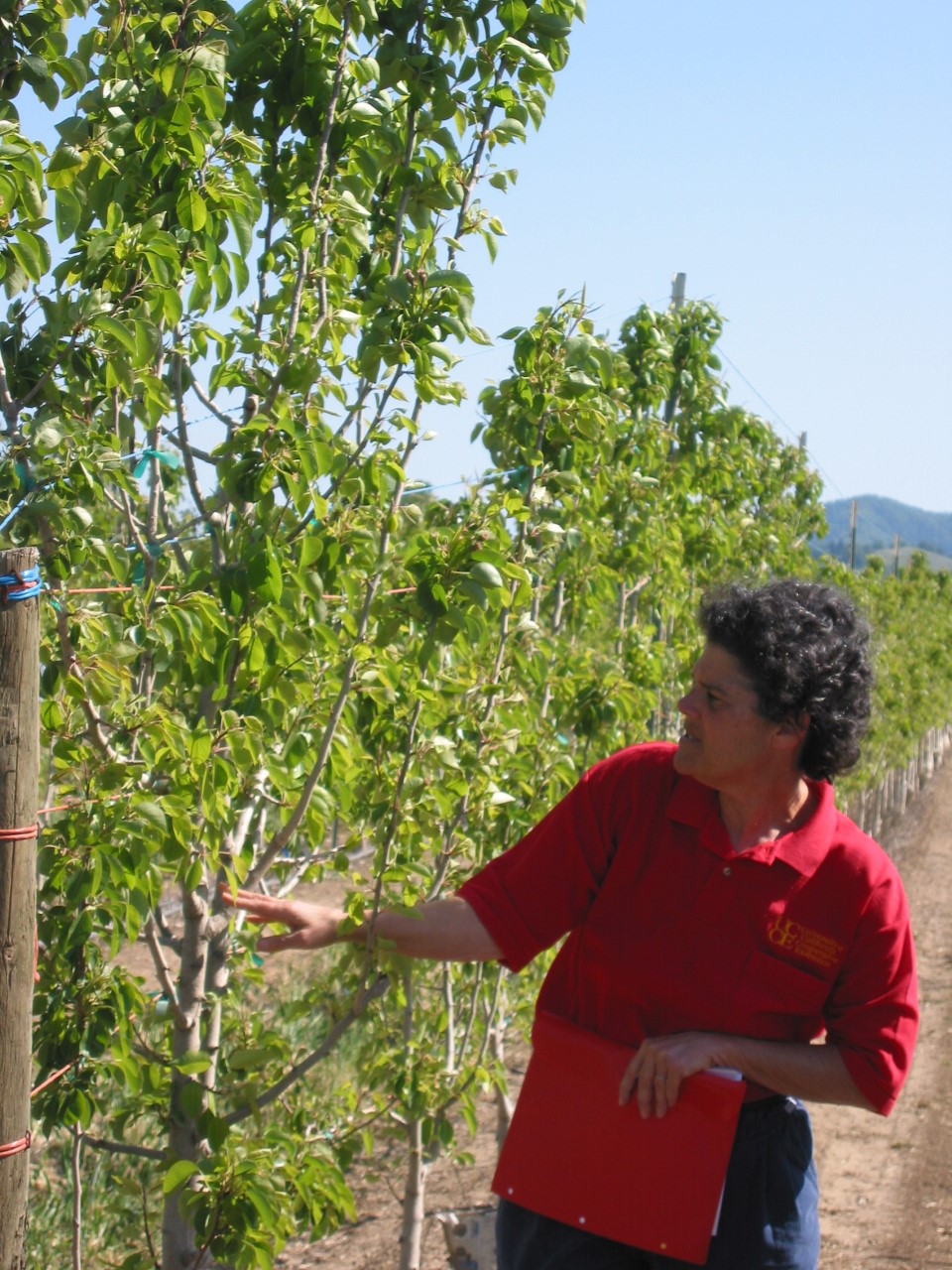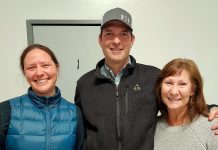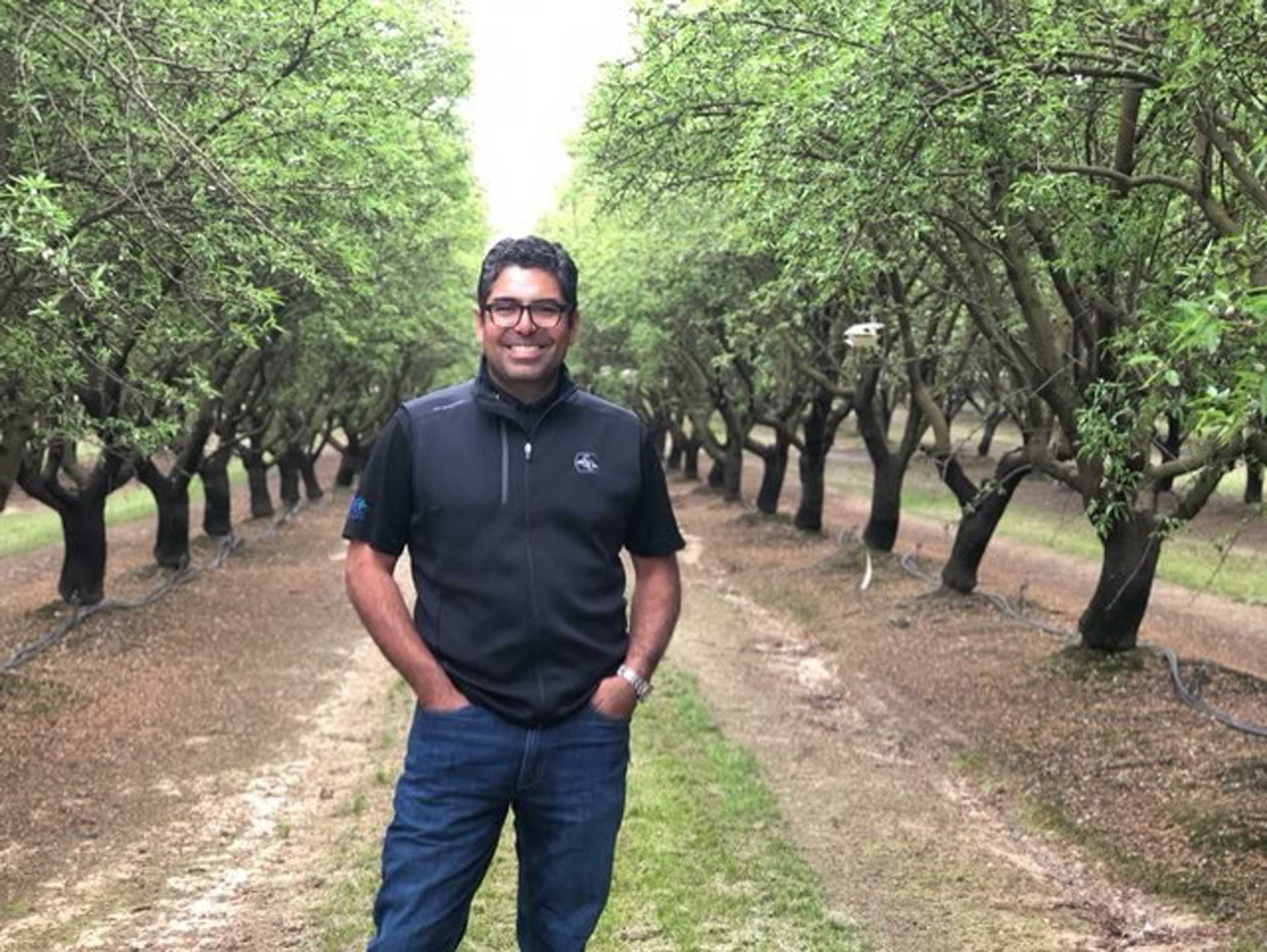After 36 years in the industry, Rachel Elkins, UCCE Pomology Farm Advisor, Lake and Mendocino Counties and County Director, Lake County, is enjoying the best of both her working and retired worlds. Elkins returned to work part-time as an emeritus farm advisor the day she retired.
“I still have my office, and I’m doing what I like to do, which is being purely a farm advisor, working with growers and the industry,” said Elkins.
As a native of Richmond, Calif., Elkins’ early exposure to agriculture was mostly in passing; commercially grown flowers were popular for the area. While she was a student at University of the Pacific (UOP), Elkins did a winter project in Hawaii about ancient Hawaiian agriculture and religion, and the spark of interest was born.
“I learned how their cultural and agricultural beliefs were intertwined with their religious beliefs, and I became interested in agriculture while doing that,” said Elkins.
The transition to agriculture wasn’t immediate. Elkins did a few semesters at UC Davis to study range management, but found herself back at UOP shortly thereafter. After working as a loan department typist, then secretary, then entomology librarian at UC Berkeley, Elkins earned a second bachelor’s degree in agricultural pest management from Berkeley.
She learned from some of the original IPM faculty and practitioners, who would ultimately become icons in the field, such as Ray Smith, Lou Falcon, Bob Raabe and Boise Day. She spent three years working in the entomology department, followed by work with the USDA involving the biological control of weeds.
When that wrapped, she did an internship with pioneer UC IPM advisor Bill Barnett that introduced her to cooperative extension for the first time. This was in 1982. Five years later, she would land her position in Lake County and build her career there.
“It basically evolved. There was no plan,” said Elkins of how she found herself in agriculture. “I had to be willing to get out of my comfort zone and go where the opportunity was.”
Elkins went to graduate school at UC Davis, where she earned a master’s degree in plant protection and pest management. She then earned a second master’s in horticulture, specializing in pomology.
How Elkins chose her specialties was also an evolution. “I was involved in an almond cover crop project and I gravitated more towards working with trees,” said Elkins. “I didn’t know in what fashion, but I had already decided I was going to stay working in trees.”
The Pheromone Puffer
One of the biggest and most well-known projects Elkins was involved with was the pheromone puffer.
Elkins began working on pheromones in 1987, when Pacific Biocontrol and pheromone disruption was just getting started and being tested in orchards. They quickly found there were several complications with them. Climbing ladders in the field to place the emitters at 400 units per acre made it very labor-intensive. Additionally, the units had pheromone release issues caused by temperature.
Elkins met Dr. Harry Shorey, a researcher from UC Riverside, at a meeting, and he shared with her a new contraption and concept for widely-spaced “active emission” emitters that used a propellant and released larger quantities of pheromone, instead of many emitters releasing smaller amounts.
Shorey’s device was already demonstrating good results in crops such as table grapes and cotton. He suggested trying them for codling moth in pear orchards, and Elkins offered to collaborate.
“In order for them to work really well, we needed a large area, about 160 acres,” said Elkins. “But we had tremendous codling moth problems, and we couldn’t risk all this acreage on these pheromones when we didn’t know if they would work. So, we negotiated a plot design.”
That design consisted of 160 acres under four to five original growers. In the center of each plot was a section designated for pheromones only, while the surrounding acreage included pesticides and pheromones.
The project was intensive and involved a tremendous amount of monitoring, teamwork and involvement from Paramount Farming, now known as The Wonderful Company, to shepherd the puffer device to market commercially. At the end of three years, codling moth numbers were reduced to zero and the insecticide was removed. By the end of the project, 1,500 acres of pears had been treated, which looked promising for the emitter’s next use in walnuts.
Elkins began this project in 1996 and finished in 2001. “Then, we published a cost study on the changes and the incredible money savings on pear psylla and mite control,” said Elkins. “We didn’t have those secondary [pest] problems anymore. We had biological control of our orchards. We do face other occasional localized secondary pests, but none as severe as psylla and mites.”
A Changing Market
Once Elkins moved into pomology, her primary crop continued to be pears. Over the course of her more than three decades in the field, she has seen incredible shrinkage of the pear industry.
There are currently three states that are the main pear producers in the U.S.: Washington, Oregon and California, in that order. New York and Michigan also produce. California has a history of being a canning-based industry, but that changed with the public’s increasing taste for fresh produce rather than canned. As canned demand decreased, there were fewer remaining canneries, which placed a bigger burden on the pack industry. But this industry is also experiencing a narrowing market as competition increased.
For example, Washington has increased their pear acreage, which contends with California pears, thus shrinking that market. Additionally, U.S.-grown pears have to compete with foreign imports, such as those from Argentina, which are still on store shelves when California pear harvest begins in July. This has forced growers to move toward vertically integrated operations, expanding from being a grower to include shipper and marketer.
It’s also labor-intensive and costly to harvest pears.
“There’s more emphasis on trying to do labor savings,” said Elkins. “Labor hangs everything up, so as change goes, will it be orchard configuration? Mechanical harvesting? The economics of making these changes is not cheap. Growers can’t just stop and change everything over. It doesn’t work like that, and cash flow is pretty important.
“The industry is going to have to move into mechanization in a big manner,” explained Elkins. “There’s not a new influx of labor. Many farmers and laborers are approaching retirement age. And many younger workers are not trained or knowledgeable about picking fruit or pruning. There’s also more competition for the same labor: a pear grower is picking, a cannabis grower is getting ready to trim, and wine grape growers are ready to harvest, in the same or other locations.”
Orchards are changing — from labor to water usage, to rootstock and pest management — and what the orchard of the future will look like has yet to be seen.
“The biggest changes are going to be orchard configuration and labor to fit the new model in order to get work done from beginning to end,” said Elkins.
Elkins may now be officially retired, but she and many of her retired UCCE colleagues still receive emails and phone calls from growers. As private research and development is becoming more prevalent in the fruit and nut industry, there is still a need for cooperative extension, and Elkins hopes that industries and growers in California speak up and continue to support the work of cooperative extension.
“It is truly a wonderful and useful career, and a worthwhile one for an aspiring younger generation.”











